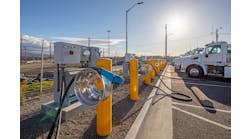Takeoff for New Terminal One: Construction Begins on JFK Airport Microgrid
John F. Kennedy International Airport in Queens, New York, long celebrated as where “America meets the world,” and the place where the Beatles first met America and vice versa, has not really put its best face forward in recent decades.
It got old, like we all do. It needed a remake and fresh jolt of energy. Yeah, yeah, yeah!
One giant remake is under way at JFK, as a $19 billion rebuild and upgrade continues across multiple terminals. The biggest of these is the New Terminal One project, which includes what might be the largest airport microgrid in the U.S. At 12 MW, it will supply half the facility’s energy load and electrifies all ground operations.
That energy phase of the JFK Airport makeover is now under way with crews installing conduit to prepare for the largest rooftop solar array in New York City –– 6.6 MW generated from 13,000 photovoltaic panels.
“This microgrid is one of the most advanced ever built,” Juan Macias, CEO of public infrastructure microgrid developer AlphaStruxure, said in a joint press conference with airport officials and project contributor Schneider Electric. “It really is four microgrids federated as one, some on the roof and one at ground level.”
The first phase of the JFK New Terminal One microgrid is due to be completed and operational by 2026. The entire project is slated to finish by 2030.
Follow our history of the JFK Airport Microgrid
The original Idlewild Airport opened in 1948. It was renamed to honor President John F. Kennedy in late 1963 shortly after he was assassinated. Seven years ago, the city of New York, realizing the impact of JFK as a point of entry for so many international travelers arriving at the U.S., decided to give the good old Idlewild Airport a modernized makeover. The JFK Vision Plan, as it is called, started with upgrading Terminals 8 and 4, saving the $9.5 billion Terminal One rebuild for nearly last. It is the key piece anchoring the airport’s south side development.
Steel and glass: The JFK Makeover from top down
Once completed, New Terminal One will cover 2.6 million square feet and offer 23 new gates.
“The amount of steel in this new phase is equivalent to five Eiffel Towers,” Jennifer Aument, CEO of JFK New Terminal One, said during the press conference with media. “We are talking about a tremendous, large-scale terminal. . . We are building the future here.”
Powering that future will be the completely unique microgrid integrating the rooftop solar, battery storage and, eventually, fuel cells that offer flexible backup power. Schneider Electric, which created AlphaStruxure in a joint venture with investment giant Carlyle Group, will handle microgrid control, software and ongoing services.
Jana Gerber, who heads the microgrid division of Schneider Electric in North America, said that on-site and islandable microgrids, which can operate when the main grid is down, are the perfect solution for major airports where downtime is unacceptable.
“Plugging into the grid is taking longer, costing more and not always a source of clean power,” Gerber pointed out. “This is why microgrids are emerging as a key driver of the energy transition.”
Timeline on microgrid components
The solar panel installation will begin early next year once the conduit work is in place, AlphaStruxure’s Macias noted. E-J Electric Installation will install the panels.
The battery storage and fuel cell equipment will be constructed later in 2025.
Once fully operational, the microgrid will recover heat from the fuel cells to generate chilled water and hot water for the terminal. AlphaStruxure is financing the microgrid project through an Energy as a Service contract, in which the developer carries upfront costs but recoups its time and investment through a long-term agreement with the customer.
The New York Port Authority is one of the primary government bodies involved in the JFK Airport upgrade and New Terminal One project. The Port Authority is also overseeing construction of a 12-MW solar canopy at the airport’s long-term Parking Lot 9. That system will include 7.5 MW of battery storage capacity.
The microgrid will also enable the electrification of all Terminal One group equipment, including trucks on the tarmac, Aument said.
Juggling major construction amidst so many moving parts
Doing all this work at the same time — building a microgrid, new gates, new roads and continuing ground operations — is a world-class challenge, admitted Jessica Forse, who is project executive for the JFK Airport Redevelopment Program for infrastructure design firm HNTB. Some 2,000 construction workers will be on site at the peak of the project, according to reports.
One of the biggest considerations also is the smallest: Where to install solar at a busy global aviation hub?
“There’s a lot of space but not all of it is intuitive ,” Forse said. “How can you do that smartly and in places that work?”
The focus is on rooftop solar and integrating the other portions of the microgrid “intuitively” within the newly built environment, she added.









